Perrin Air Force Base
Perrin Air Force Base 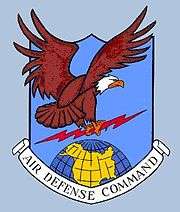 | |
|---|---|
|
Part of Air Training Command (ATC) Air Defense Command | |
| Located near: Sherman, Texas | |
|
4780th Air Defense Wing Convair F-102A-75-CO Delta Dagger 56-1411 | |
| Coordinates | 33°42′47.92″N 96°40′25.61″W / 33.7133111°N 96.6737806°W |
| Type | Air Force Base |
| Site information | |
| Controlled by | United States Air Force |
| Site history | |
| Built | 1941 |
| In use | Open 1941 - closed 1971 |
| Airfield information | |||||||||||||||
|---|---|---|---|---|---|---|---|---|---|---|---|---|---|---|---|
| Summary | |||||||||||||||
| Elevation AMSL | 749 ft / 228 m | ||||||||||||||
| Coordinates | 33°42′51″N 096°40′25″W / 33.71417°N 96.67361°WCoordinates: 33°42′51″N 096°40′25″W / 33.71417°N 96.67361°W | ||||||||||||||
| Map | |||||||||||||||
 Location of Perrin Air Force Base | |||||||||||||||
| Runways | |||||||||||||||
| |||||||||||||||
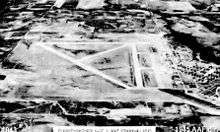
Perrin Air Force Base is an inactive United States Air Force base, approximately 7 miles northwest of Sherman, Texas. It was active during World War II as pilot training airfield and during the Cold War as a combat crew and flying training base. It was closed on 30 June 1971.
After seeing the fighters take off from the base, a young Chesley Sullenberger became interested in flying.[1] [2]
History
Perrin Air Force Base began as an army air field and was the first basic flying training school to become operational after the Japanese attack on Pearl Harbor on 7 December 1941.
In the spring of 1941, Grayson County leaders began to discuss the possibilities of a U.S. Army Air Corps basic flying school to be built in Grayson County. In March 1941 Grayson County Judge Jake J. Loy went to Washington, DC, to further the project idea. After his visit to Washington, Judge Loy returned to Sherman and began to work on the project with county commissioners, and a tract of land was subsequently selected that was suitable for use as a flying field.
On 16 June 1941, the Office of the Chief of the Air Corps drew up a program for construction. A tentative authorized strength of 199 officers, 422 cadets, 1730 enlisted men, and funds in the amount of $3,966,833.00 were ordered and set aside for the construction of the airfield. The lease was signed by the United States Government and Grayson County on 1 July 1941 and the Army Corps of Engineers started construction on the newly established Grayson Basic Flying School the same week.
On 9 August 1941, Major Robert J. Warren was the first person to report to duty at the partially constructed airfield, assuming duties as project officer and temporary commanding officer. Ten days later, five enlisted men arrived from San Angelo, TX, to assist Major Warren in the development of the airstrip, hangars, barracks, and field headquarters building.
The airfield was laid out with four runways in a triangle pattern, consisting of 4500x150(N/S), 2700x150(NE/SW), 4200x150(E/W), 5137x150(NW/SE), all constructed of concrete. A large parking apron was constructed to accommodate the planned basic (phase II) training aircraft with at least 6 maintenance hangars and supporting buildings. East of the airfield, a ground support station was constructed consisting of about several hundred buildings based on standardized plans and architectural drawings. The buildings were designed to be the "cheapest, temporary character with structural stability only sufficient to meet the needs of the service which the structure is intended to fulfill during the period of its contemplated war use." To conserve critical materials, most facilities were constructed of wood, concrete, brick, gypsum board and concrete asbestos. Metal was sparsely used. Perrin Field was designed to be nearly self-sufficient, with not only hangars, but barracks, warehouses, hospitals, dental clinics, dining halls, and maintenance shops were needed. There were libraries, social clubs for both the officers and enlisted men, and stores.
In addition to the main airfield, there were four auxiliary airfields constructed to support the flying training at Perrin Army Airfield:
- Perrin AAF Aux No. 1 - Gibbons Field 33°39′07″N 96°43′23″W / 33.65194°N 96.72306°W
- Perrin AAF Aux No. 2 - Gaskin Field 33°20′29″N 96°46′02″W / 33.34139°N 96.76722°W
- Perrin AAF Aux No. 3 - Gainesville Field 33°39′05″N 097°11′49″W / 33.65139°N 97.19694°W
- Later became Gainesville Army Airfield
- Perrin AAF Aux No. 4 - Burton Field 33°42′10″N 96°23′30″W / 33.70278°N 96.39167°W
On 21 August 1941, the first aircraft, a Vultee BT-13 Valiant arrived at the newly constructed Grayson Basic Flying School. The airfield was officially activated on 20 September 1941 by the Army Air Forces Training Command, Gulf Coast Training Center. It was placed under the jurisdiction of the Army Air Corps Pilot School (Basic) activated. The mission of the new airfield was the training of aviation cadets in the basic (intermediate) phase of flying training (phase 2).
On 12 November 1941, Lieutenant Colonel Donald G. Stitt was assigned to the airfield and assumed command on 19 November 1941, with Major Warren remaining as project officer. Lieutenant Colonel Stitt was, in effect, the first commander of the field.
World War II
On 7 December 1941, the strength of the airfield stood at 90 officers and 545 enlisted men, with the first class of cadets expected by the end of December. In January 1942, the installation was renamed Perrin Field in memory of the late Lieutenant Colonel Elmer D. Perrin, a native Texan who had been killed in a 21 June 1941 takeoff crash during an acceptance test of B-26 Marauder bomber, 40-1386, near the aircraft plant. He had served as the district supervisor, Eastern Air Corps Procurement District since 1939, and was the Air Corps representative to the Glenn L. Martin Company, at Middle River, northeast of Baltimore, Maryland. Lt. Col. Perrin was the Air Corps's most experienced B-26 pilot at the time of this accident.
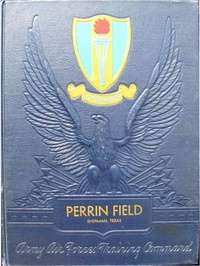
On 8 January 1943, the War Department constituted and activated the 32d Flying Training Wing (Basic) at Perrin and assigned it to the AAF Central Flying Training Command.
Normal manpower strength at base occurred in early 1943, averaging 2500 enlisted men and 300 officers. Training aircraft used at Perrin Field included approximately 250 BT-13's and AT-6's, with approximately 550 maintenance personnel working 24-hour shifts. Pilot cadet classes numbered between 300 and 400 students. Perrin Field hosted the 32nd Flying Training Wing from September 1943 to October 1945, graduating over 10,000 pilots, including cadets from Brazil, Mexico, Guatemala, the Philippines, and Ecuador. The airfield also maintained a branch prisoner-of-war camp, holding about 200 German POWs.
Basic pilot training was discontinued at the base in late 1945, and an instructor school was established to maintain instructor proficiency and provide refresher training for oversea returnees and behind-the-line pilots, but the base was deactivated in November 1946. Perrin became a storage facility for aircraft such as the AT-6 Texan trainer, the B-25 Mitchell bomber, and other equipment, such as tractors and bulldozers. The only operational aircraft was the C-47 Skytrain.
Cold War

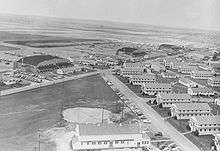



On 1 April 1948, Perrin Field was reactivated under the newly established United States Air Force, hosting the 3555th Basic Pilot Training Wing from August 1948 to June 1952. A shortage of funds forced Air Training Command (ATC) to open the base with only a caretaker group on hand. Three months later, on 1 July, the base began training. Training squadrons under the 3555th PTW were:
- 3556th Combat Crew Training Squadron
- 3558th Combat Crew Training Squadron
It resumed its mission of basic single-engine pilot training under the Air Training Command (ATC) and continued until December 1951. Beginning in January 1952, Perrin began advanced single engine pilot training, flying the T-28 Trojan. This training ended in December 1952. In March 1952, A-26 Invader medium bomber training was transferred and conducted at Perrin.
Beginning in 1951, NATO/Allied students began pilot training at Perrin, which continued until 1962 when this role was transferred to the flying training wing at Sheppard AFB, TX. On 17 July 1952, Perrin was designated a permanent air force installation and its name officially changed to Perrin Air Force Base. Perrin was transformed to crew training role for all-weather fighter interceptors and longer 8000 and 9,000-foot (2,700 m) runways were built to accommodate the T-33 Shooting Star and F-86 Sabre that arrived in December 1952.
During the 1950s to early 1960s, Perrin host wing, the 3555th, went through several name changes, being known as the 3555th Flying Training Wing (fighter [June 1952 - September 1954]), the 3555th Combat Crew Training Wing (advanced interceptor [September 1954 – August 1958]), and the 3555th Flying Training Wing (advanced interceptor [August 1958 to July 1962]).
In July 1962, Perrin was transferred from ATC to the Air Defense Command (ADC) and the 4780th Air Defense Wing absorbed the ATC 3555th Training Wing which was discontinued. The 4780th conducted training in the F-102 and TF-102 Delta Dagger. The training squadrons transferred their personnel and equipmentas follows:
- 3556th CCTS --> 4781st Combat Crew Training Squadron
- 3558th CCTS --> 4782d Combat Crew Training Squadron
From 1962 to 1971, Perrin had the largest fleet of F-102s in the U.S. Air Force and became the only F-102 replacement training base within the Air Defense Command, which was later redesignated the Aerospace Defense Command (ADC) in January 1968.
In October 1962, during the Cuban Missile Crisis, a number of Perrin AFB aircraft were placed on alert, while others were deployed to bases in Florida for alert and air defense missions.
The 4780th had two flying squadrons, the 4781st and 4782nd Combat Crew Training Squadrons. In 1964, the 4780th Air Defense Wing was chosen to host the Air Defense Command Life Support School at the nearby Lake Texoma. The school was initiated to give life support and ejection training to aircrews flying ADC aircraft and Air National Guard units that supported the ADC mission. Prior to the school's establishment, ADC had a 22% aircraft mishap fatality rate, but after the first year it fell to 5%.
The school trained and graduated over 11,000 aircrew members including forty-nine United States astronauts, several USAF F-102s having been bailed to the National Aeronautics and Space Administration (NASA) for astronaut proficiency training at the NASA Flight Operations Facility at Ellington Air Force Base (later Ellington Field Air National Guard Base) near Houston. Perrin also utilized HH-43B Huskie helicopters for local aircraft rescue and fire fighting.
In April 1967, Perrin assumed an added training mission with the activation of the Air Training Command's 3251st Flying Training Wing when instructor pilot training was transferred from Randolph AFB, Texas. As a tenant unit, the 3251st FTW's 3251st Flying Training Squadron trained already qualified USAF pilots as Cessna T-37 undergraduate pilot training (UPT) instructors.

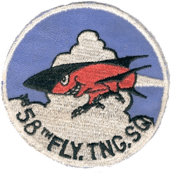
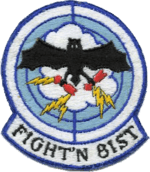
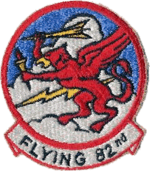
Closure
On 3 March 1971, it was announced that Perrin AFB would close due mainly to a change in pilot training requirements, primarily the retirement of the F-102 from front-line service. In addition to the phaseout of the F-102, airspace congestion following the opening of the new Dallas-Fort Worth International Airport was also considered to be a secondary factor.
On 13 May 1971, the last graduating class flew its F-102s in formation over Sherman and Denison as a farewell to its two host cities. A few days later, the last of the F-102 Delta Daggers left the base and the 4780th Air Defense Wing was inactivated. On 15 May the T-37 instructor pilot training transferred to Randolph Air Force Base in Universal City, Texas near San Antonio.
Perrin AFB closed on 30 June 1971.
Current use
The closed Perrin Air Force Base was turned over to the Grayson County Community College and to the County of Grayson. The name of the field was changed to Grayson County Airport, which, in November 2007, was renamed to North Texas Regional Airport. Today, in addition to serving as a general aviation airport, several businesses, as well as a juvenile detention center/boot-camp and adult probation center are built upon former barracks and nearby areas. Grayson County College uses several of the buildings for its course offerings. The college previously operated the former base golf course, but as of 2017 the course was closed.
Today, a small group of local Sherman and Denison citizens have held the memory of Perrin together, hosting nine Perrin Field reunions since the early 1980s. The Perrin AFB Research Foundation was established in 1998. There is a small museum dedicated to the former Perrin Air Force Base at the airport.
See also
| Wikimedia Commons has media related to Perrin Air Force Base. |
| Wikimedia Commons has media related to Perrin Army Airfield. |
References
![]() This article incorporates public domain material from the Air Force Historical Research Agency website http://www.afhra.af.mil/.
This article incorporates public domain material from the Air Force Historical Research Agency website http://www.afhra.af.mil/.
- ↑ Rivera, Ray (January 16, 2009). "A Pilot Becomes a Hero Years in the Making". The New York Times.
- ↑ Kaufmann, Carol (January 16, 2009). "Hudson River Hero". AARP Today. American Association of Retired Persons. Retrieved March 16, 2009.


